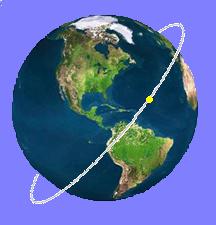
INTRODUCTION
Every object in Earth orbit below about 1000 km altitude is subject to atmospheric drag, which will decrease its energy and slowly reduce altitude in a spiral that will eventually cause it to reenter the Earth's atmosphere. Objects with an initial altitude of 1000 km may take centuries to complete this process. However, objects at 500 km altitude will normally decay within about 10 years, and the average object at 200 km altitude will decay within a very few days,
Most of these objects will burn up in the Earth's atmosphere during reentry and thus pose no hazard to people or property on the ground. However, objects with an initial mass over about 1000 kg (one ton) will generally not suffer total ablation and will drop fragments on the Earth's surface.
REENTRY PREDICTIONS
Because of an imperfect knowledge of the Earth's upper atmospheric density in the future (as well as in the present) the most accurate reentry predictions have an error of at least 10% in time. This error is independent of the time scale involved. Thus if a satellite or piece of debris is due to decay within about a year, the error in predicting the time of reentry will be greater than one month. On the other hand, if an object is due to decay in the next 24 hours, the best prediction can only specify the actual time to within about two and one half hours. Since such an object orbits the Earth in less the 90 minutes, the prediction of an actual uncontrolled reentry location is virtually impossible.
Of course we can predict the orbital path of an object very accurately for a few weeks, and knowledge of this path can be used to exclude large areas of the Earth's surface from any reentry danger. It is only locations underneath the orbital path (and a few tens of kilometres each side of the path) that could lie within a hazard zone.
For long term predictions, there is only one orbital parameter that can guide any locational forecast, and that is the inclination of the orbit. This is the only orbital parameter that changes very little over long periods of time.
LATITUDINAL REENTRY EXCLUSION
The diagram below shows the '3D' path of a satellite in a circular low Earth orbit (LEO) - and note that as a satellite nears reentry its orbit will be close to circular, even though it may have initially been quite elliptical.

This satellite travels around the Earth in a plane that passes through the centre of the Earth and that is inclined at an angle to the Earth's equatorial plane. This angle is called the inclination of the orbit.
From a surface perspective we are more interested in the ground track over which the satellite passes. This is shown below.
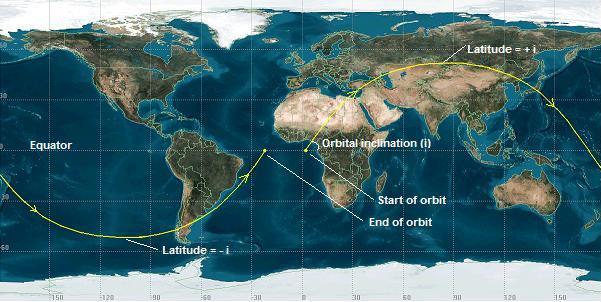
The figure shows one complete orbit of the satellite, starting at a point where it crosses the equator travelling north. This point is called the ascending node of the orbit.
Note that the orbit is completed over a longitudinal range of less than 360 degrees. This is because, while the satellite is moving in a plane that is relatively fixed in space (ie with respect to the stars), the Earth is rotating. In the roughly 90 minutes that it takes for a LEO satellite to orbit the Earth, it has rotated ~35 degrees about its axis, and so one complete orbit takes place over only 325 degrees of longitude. For this reason the subsequent ground tracks will not overlie the first, and a plot of many ground tracks into the future will fill most of the longitudinal space around the globe.
What we can note however, is that the maximum latitude reached by the ground track is equal to the inclination of the orbit. Points on the Earth's surface that have a latitude greater than the orbital inclination will never be overflown by the satellite, and thus are excluded from any reentry debris that may make it to the ground during reentry of this object.
Only satellites with an inclination of 90 degrees overfly every point on the Earth's surface. Satellites with inclinations greater than 90 degrees are said to be in retrograde orbits (because they orbit in the opposite direction to the Earth's rotation), and can be considered to have an 'effective' inclination of 180 - (true inclination) degrees. Thus an object in a retrograde orbit with an inclination of 120 degrees will have a ground track that never exceeds 180-120=60 degrees in latitude.
LATITUDINAL REENTRY PROBABILITY
We can thus see that the probability of reentry over a latitude greater than the object orbital inclination is zero. What about locations at latitudes less than the inclination? Because the satellite ground track generally spends more time at the higher latitudes, the probability of a reentry is dependent on latitude and we can calculate what that probability is for each latitude band.
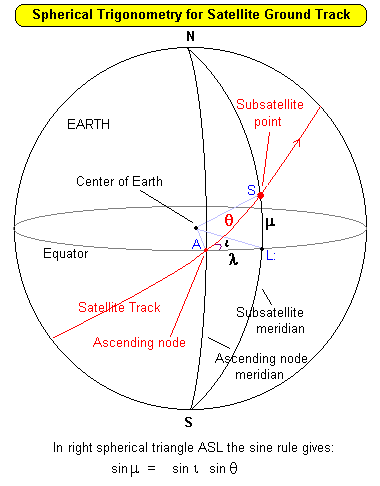
From the above spherical trig diagram above we have that:
where
To obtain a probability only in terms of latitude and inclination we must eliminate θ from the above formula. We note that
The graph below plots this probability for various orbital inclinations from 30 to 90 degrees over a latitudinal band one degree in width.
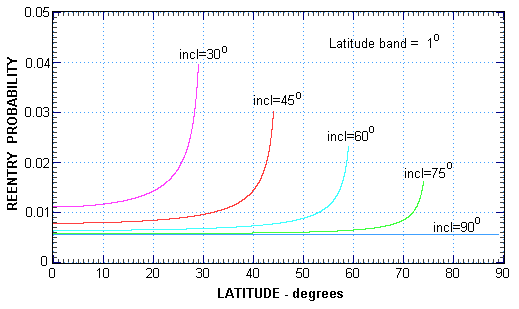
Note that the probability of reentry occuring at latitudes near the orbital inclination is greater than it is around the equator. The exact magnitude of the increase ranges from a value of about 4 at an inclination of 30 degrees to a value of 2.6 at an inclination of 75 degrees. When the inclination is 90 degrees the probability is the same for all latitudinal bands. This is because when ι = 90o then μ = θ and equal increments of time which are equal increments of θ are then equal increments of μ(latitude). The latitude independent probability in this case is 2 δμ / 2 π which is 1/180 = 0.056 for a one degree latitudinal band.
The probability values can also be displayed as a density overlay on a ground projection, as shown below for an orbital inclination of about 55 degrees.
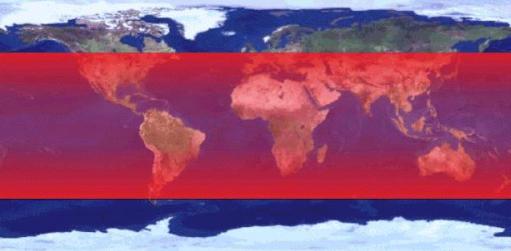
As a final comment we would note that the reentry process spreads debris over a large area, typically measuring at least 20 km cross track by 1000 km along track. In light of this we need to be careful how we interpret the above probabilities.
 Australian Space
Academy
Australian Space
Academy